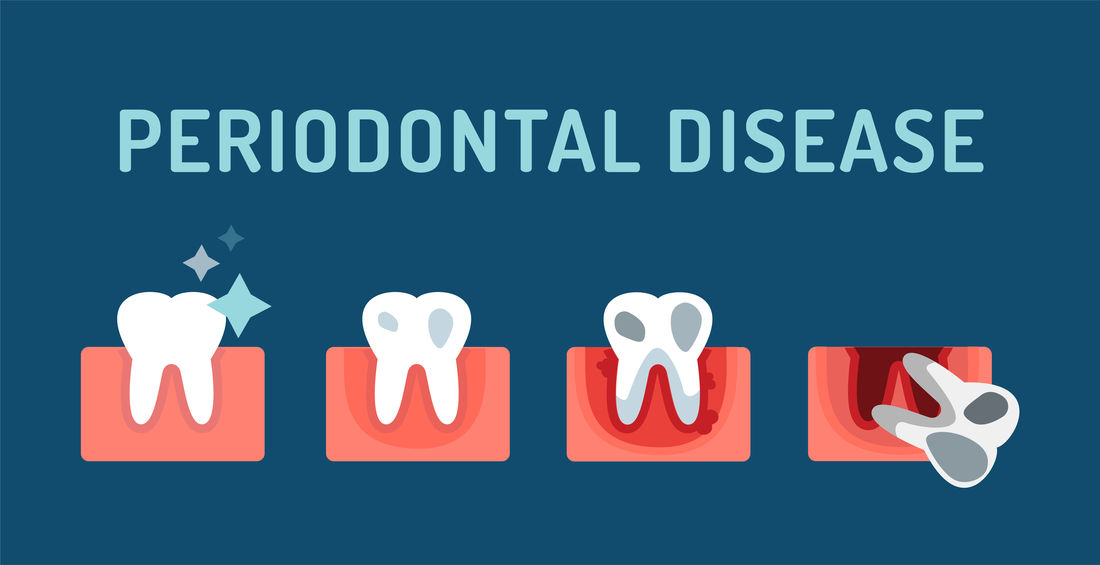Bookmark Our Page By Adding Our Website To Your Home Screen
Shop 20, 165-191 Macquarie Street
Liverpool, NSW 2170
(02) 9822 5590
(02) 9822 5591
Monday - Friday
9am-5pm
Saturday: By appointments only
Shop 20, 165-191 Macquarie Street,
Liverpool, NSW 2170
(02) 9822 5590
(02) 9822 5591
Monday – Friday
9am-5pm
Saturday: By appointments only
Periodontal diseases range from simple gum inflammation to serious disease that results in major damage to the soft tissue and bone that support the teeth. In the worst cases, teeth are lost.
Gum disease is a threat to your oral health. Research is also pointing to possible health effects of periodontal diseases that go well beyond your mouth (more about this later). Whether it is stopped, slowed or gets worse depends a great deal on how well you care for your teeth and gums every day, from this point forward.
What causes Periodontal Disease?
Our mouths are full of bacteria. These bacteria, along with mucus and other particles, constantly form a sticky, colorless "plaque" on teeth. Brushing and flossing help get rid of plaque. Plaque that is not removed can harden and form bacteria-harboring "tartar" that brushing doesn't clean. Only a professional cleaning by a dentist or dental hygienist can remove tartar.
Gingivitis
The longer plaque and tartar are on teeth, the more harmful they become. The bacteria cause inflammation of the gums that is called "gingivitis." In gingivitis, the gums become red, swollen and can bleed easily. Gingivitis is a mild form of gum disease that can usually be reversed with daily brushing and flossing, and regular cleaning by a dentist or dental hygienist. This form of gum disease does not include any loss of bone and tissue that hold teeth in place.
Periodontitis
When gingivitis is not treated, it can advance to "periodontitis" (which means "inflammation around the tooth.") In periodontitis, gums pull away from the teeth and form "pockets" that are infected. The body's immune system fights the bacteria as the plaque spreads and grows below the gum line. Bacterial toxins and the body's enzymes fighting the infection actually start to break down the bone and connective tissue that hold teeth in place. If not treated, the bones, gums, and connective tissue that support the teeth are destroyed. The teeth may eventually become loose and have to be removed.
Risk Factors
Who gets Periodontal Disease?
People usually don't show signs of gum disease until they are in their 30s or 40s. Men are more likely to have periodontal disease than women. Although teenagers rarely develop periodontitis, they can develop gingivitis, the milder form of gum disease. Most commonly, gum disease develops when plaque is allowed to build up along and under the gum line.
What can I do to Prevent Gum Disease?
Here are some things you can do to prevent periodontal diseases:
How do I Know if I Have Periodontal Disease?
Symptoms are often not noticeable until the disease is advanced. They include:
Any of these symptoms may signal a serious problem, which should be checked by a dentist. At your dental visit:
How is Periodontal Disease Treated?
The main goal of treatment is to control the infection. The number and types of treatment will vary, depending on the extent of the gum disease. Any type of treatment requires that the patient keep up good daily care at home. Additionally, modifying certain behaviors, such as quitting tobacco use, might also be suggested as a way to improve treatment outcome.
Deep Cleaning (Scaling and Root Planing)
The dentist, periodontist or dental hygienist removes the plaque through a deep-cleaning method called scaling and root planing. Scaling means scraping off the tartar from above and below the gum line. Root planing gets rid of rough spots on the tooth root where the germs gather, and helps remove bacteria that contribute to the disease.Medications
Medications may be used with treatment that includes scaling and root planing, but they cannot always take the place of surgery. Depending on the severity of gum disease, the dentist or periodontist may still suggest surgical treatment.